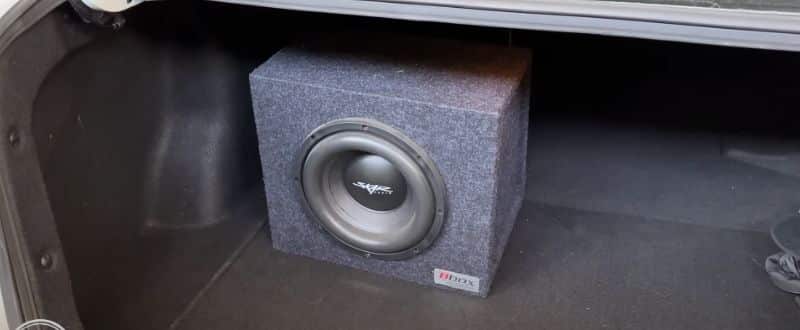Don't know how to fix a car subwoofer with no sound? You're in the right place! Fixing this issue often involves performing some simple diagnostic tests on your overall audio system. If your amplifier turns on and works fine but your subwoofer produces no sound, the problem might be related to installation errors or other common issues.
In this guide, I’ll walk you through the most frequent mistakes that can prevent subwoofers from working. I'll start with the simplest problems and progress to more technical solutions to help you pinpoint and fix the issue with ease.
In This Article
The Easy Car Subwoofer Fixes - Problems that Goes Unnoticed
Before I go into the complicated diagnostics, you may want to check for basic malfunctions. Let me look at the simple solutions that might bring your bass back to life!
Is There Any Physical Damage?
Look closely and examine your subwoofer to see if there is any physical damage that might be the source of the problem. Check for any tears or rips in the cone, or indications of blown fuses inside the subwoofer itself (see the handbook for location).
Are You Even Able to Turn on Your Amplifier?
Although it may appear self-evident, it is important to remember that even the most simple things can cause us to make mistakes. Ensure that the subwoofer and amplifier are properly powered. Check all power connections, including the battery and ground connections. Make sure the power cables are secure and not damaged.
Are the RCAs Correctly Plugged in?
The RCA cables transport the audio signal from your head unit to the amplifier. Double-check to ensure they are plugged into the appropriate jacks on both ends. If the connections are loose, your subwoofer will not produce any sound. Test the RCA outputs from the head unit by connecting another device that you know works, or use a multimeter to check for output voltage. Also, inspect the RCA cables for signs of damage or wear.
Have You Checked for the Fader Controls?
Fader controls are frequently found on modern head units. These settings allow you to change the balance between the front and rear speakers and the subwoofer. To prevent your subwoofer from being effectively muted, check that the fader is not set all the way to the front. If necessary, use the handbook that came with your head unit.
Digging a Little Deeper - Settings and Signal Issues of Car Subwoofer
If the simple checks cannot solve your sub’s issue, you may have more technical issues. You will have to troubleshoot them the following way.
Step 1: Check for the Amp Settings
The way your amplifier handles the audio stream is determined by a number of parameters. Gain, crossover frequency, and bass boost are frequently among them. To make sure things are adjusted properly, refer to your amplifier's manual—it is the Rosetta Stone of amp settings or you may seek help from my guide on amp settings. Remember that, If you choose the wrong crossover frequency, your subwoofer may not get the needed bass signals and become underpowered.
Step 2: Check for the Head Unit Settings
Is there a subwoofer output control on your head unit? Make sure it is not disabled or muted. In the same vein, some head units have integrated crossovers. If they are enabled, they may affect the crossover parameters of the amplifier. See the user manual for instructions for your head unit.
Step 3: Check for the Fuse Blows
Fuses are the miniature heroes of your electrical system; they give their lives shielding your devices against spikes in power. However, a blown fuse stops the power supply, which makes your subwoofer silent. If the fuse blows (which is generally evident), replace it with a fuse of the same rating as the blown one. The owner's manual for your vehicle contains the fuse details that control the amplifier's power supply.
Built-in fuses are typically found close to the power terminals on most amplifiers. Consult the handbook that came with your amplifier to see which ones need to be replaced.
Step 4: Check for Decayed Wiring
Proper and safe wiring is essential for high-quality audio. To make sure the signal gets to its destination, let me look at the connections:
Step 5: Speaker Wire Woes
These are the cables that run from your amplifier to the subwoofer, amplified signal. Verify that they are firmly attached to the appropriate terminals on the amplifier and subwoofer (positive to positive, negative to negative). Check the cables for fraying or other damage that causes signal loss.
Step 6: Remote Turn-On
Certain amplifiers require a different remote turn-on wire to turn on. If yours does, check that it is properly connected and supplying the necessary voltage to turn on the amplifier.
My EndNote
I hope this article was helpful and you have resolved the problem. If not, let me know in the comments. And, I will get back to you with an answer on how to fix your car subwoofer with no sound.
Similar Articles You May Read:

My passion for automotive mechanics began in my father’s garage. Today, I co-own a local car service agency and write for CarAudioHunt to help readers with car audio and vehicle upgrades. With years of hands-on experience, I offer expert guidance for both DIY enthusiasts and beginners.
